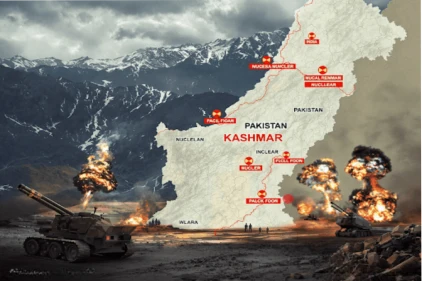Rising Nuclear Tensions in South Asia: The Impact of the India-Pakistan Conflict 2025
The fragile peace between nuclear-armed neighbors India and Pakistan shattered in April 2025 following a devastating terrorist attack in Pahalgam, Kashmir. The assault, which claimed 26 civilian lives, sparked a chain of military responses that pushed both nations to the brink of war.
India’s retaliatory Operation Sindoor marked a significant escalation, targeting alleged militant infrastructure across the Line of Control. The operation triggered intense artillery exchanges, diplomatic expulsions, and raised global concerns about nuclear security in South Asia.
The nuclear aspect of this conflict is particularly important given the region’s unstable history:
- Both nations have increasing nuclear weapons
- Limited options for conventional warfare because of nuclear deterrence
- Complicated regional relationships involving China and other powers
- Lack of formal crisis management systems
The Pahalgam attack became a critical flashpoint in the long-standing Kashmir dispute, showing how one event can quickly upset security in South Asia. This crisis brought attention to the ongoing issues of cross-border terrorism and the careful balance needed to avoid nuclear escalation in one of the most heavily militarized areas in the world.
The Pahalgam Terrorist Attack and India’s Response
The peaceful tourist destination of Pahalgam turned into a scene of destruction on April 22, 2025, when militants carried out a coordinated attack on tourist vehicles near the Lidder Valley. This attack resulted in the death of 26 people, including 25 Indian tourists and one Nepali national, making it the deadliest attack in Kashmir since 2019.
Attack Details:
- Time of attack: 2:15 PM local time
- Location: Lidder Valley road, 3km from Pahalgam town
- Method: Simultaneous ambush of three tourist vehicles
- Casualties: 26 dead, 38 injured
- Property damage: Two vehicles destroyed, one partially damaged
Indian intelligence agencies identified Lashkar-e-Taiba (LeT) as the group responsible for the attack through intercepted communications and recovered weapons with unique markings. The evidence pointed to training camps in Pakistan-administered Kashmir, leading India to present detailed reports to the international community connecting LeT operatives to Pakistani territory.
Pakistan’s government denied these accusations, blaming the attack on local Kashmir resistance groups. Their foreign ministry issued statements condemning the attack while rejecting India’s claims of supporting cross-border terrorism.
Operation Sindoor Launch:
India’s response came in the form of Operation Sindoor, a multi-faceted military campaign targeting suspected militant infrastructure. The operation included:
- Precision airstrikes on three training facilities in Pakistan-administered Kashmir
- Artillery bombardment of twelve suspected launch pads along the Line of Control
- Special forces raids on militant logistics networks
- Cyber operations targeting communication infrastructure
The Indian military reported that they neutralized 47 militants and destroyed significant terrorist infrastructure during this operation. However, Pakistani authorities stated that 31 civilians were killed as a result of these strikes, calling them unprovoked aggression against their territory.
Operation Sindoor marked India’s largest cross-border operation since 2019, utilizing advanced weapons systems such as guided munitions and armed drones. The scope of the operation extended beyond traditional strike areas, reaching suspected militant facilities in Punjab province.
The military response led to increased alert levels in both countries’ armed forces. Pakistan activated its air defense systems and deployed additional troops to forward positions, while India strengthened its military presence along the border.
Escalation along the Line of Control (LoC) and Diplomatic Fallout
The military confrontation along the Line of Control intensified dramatically following Operation Sindoor. Pakistani forces launched sustained artillery barrages targeting Indian military positions across a 350-kilometer stretch of the LoC, particularly in the Poonch and Uri sectors. Indian forces responded with heavy counter-battery fire, deploying their newly acquired K9 Vajra howitzers.
The scale of military engagement reached unprecedented levels since the 1971 war:
- Artillery Exchanges: 2,500+ shells fired across the LoC within 72 hours
- Air Space Violations: 17 recorded incidents of combat aircraft crossing the LoC
- Military Casualties: 43 soldiers killed on both sides combined
- Infrastructure Damage: 31 civilian structures destroyed in cross-border shelling
The diplomatic relationship between India and Pakistan deteriorated rapidly. Pakistan expelled India’s High Commissioner and recalled its own diplomatic mission from New Delhi. Both nations suspended visa services and closed their airspace to each other’s civilian aircraft.
Key bilateral agreements faced suspension:
- The Indus Waters Treaty – India halted water flow data sharing
- Rail and bus services across the Wagah border ceased operations
- TheSimla Agreement principles came under strain with both sides questioning its validity
Trade relations suffered immediate impact:
“All bilateral trade worth $3.1 billion annually came to a complete halt, affecting thousands of businesses across both nations” – South Asian Trade Monitor Report
Pakistan’s decision to suspend the 1960 Indus Waters Treaty sparked particular concern, given its role in managing water resources between the two nations. India responded by announcing plans to review water allocation quotas, potentially affecting agricultural output in Pakistan’s Punjab region.
The border closure extended to unofficial trade routes through Kashmir, disrupting local economies and forcing thousands of small traders to seek alternative livelihoods. Both nations increased military presence along the International Border, with India deploying additional brigades to forward positions in Punjab and Rajasthan sectors.
Rising Nuclear Tensions and Security Crisis in South Asia
The military escalation between India and Pakistan pushed nuclear threat levels to unprecedented heights. Intelligence reports indicated increased activity at Pakistan’s nuclear facilities, while India placed its strategic forces on high alert. Both nations’ nuclear-capable missile systems, including Pakistan’s Shaheen-III and India’s Agni-V, were reportedly mobilized to launch-ready positions.
Civil defense preparations intensified across major cities:
- Mumbai implemented weekly air raid drills
- Delhi established 2,500 new emergency shelters
- Karachi activated its Nuclear Emergency Response System
- Lahore distributed radiation protection guidelines
The Pakistani military’s Chief of Staff issued a stark warning about “appropriate nuclear responses to any Indian aggression,” marking the first explicit nuclear threat since the 1998 tests. India’s Defense Minister responded by reaffirming the country’s No First Use policy while emphasizing its “massive retaliation” doctrine.
Security analysts identified critical risk factors:
- Breakdown of nuclear hotline communications
- Increased missile movement near borders
- Deployment of tactical nuclear weapons
- Cyber attacks on nuclear command systems
Both governments initiated emergency population protection measures. India’s Civil Defense Corps trained 50,000 volunteers in radiation emergency response, while Pakistan’s Strategic Plans Division conducted nationwide nuclear preparedness exercises. These developments represented the most serious nuclear security crisis in South Asia since the 2001-2002 standoff.
International Reaction to the Conflict and Economic Impacts Amidst Conflict
The United Nations Security Council held an emergency session on April 25, 2025, addressing the escalating crisis. UN Secretary-General António Guterres issued a stark warning:
“The international community cannot stand idle while two nuclear powers edge closer to catastrophic conflict. We call for immediate cessation of hostilities and return to diplomatic channels.”
China and Russia blocked a UNSC resolution condemning the Pahalgam attack, citing the need for “balanced approach” in addressing regional tensions. The U.S. State Department deployed special envoy Katherine Chen to both New Delhi and Islamabad, pushing for direct bilateral talks.
Economic Impacts on Pakistan
Pakistan’s economy faced severe strain under the conflict conditions. The Pakistani rupee plummeted 15% against the dollar in the first week following Operation Sindoor. Key indicators revealed:
- Foreign exchange reserves dropped to $3.2 billion
- Inflation surged to 28%
- Stock market experienced a 22% decline
- Tourism revenue fell by 65%
The IMF suspended its ongoing $7 billion bailout program citing “security uncertainties,” pushing Pakistan closer to potential default. Major credit rating agencies downgraded Pakistan’s sovereign rating to CCC-, reflecting heightened risks of external debt repayment.
Economic Resilience in India
India’s robust economic position allowed it to weather the immediate impact, though the BSE Sensex witnessed significant volatility. Foreign investors pulled $2.3 billion from Indian markets during the crisis period.
Assessing the Risk of an All-Out War Between India and Pakistan
The probability of full-scale war between India and Pakistan has reached critical levels following Operation Sindoor. Military analysts estimate a 40% chance of broader conflict eruption within the next three months based on current escalation patterns.
Several potential triggers could push the situation beyond the threshold of limited military engagement:
- Border Violations: Repeated airspace intrusions or significant ground force movements along the LoC
- Civilian Casualties: High-casualty incidents in populated areas from either side’s military actions
- Infrastructure Attacks: Strikes on critical facilities like dams, power plants, or military installations
- Political Assassinations: Targeted killing of high-ranking officials or military leadership
The presence of tactical nuclear weapons in both arsenals adds a dangerous dimension to any potential conflict. Pakistan’s military doctrine includes the possible use of tactical nuclear weapons against conventional Indian forces, while India maintains a “no first use” policy but reserves the right to massive retaliation.
Recent military movements indicate both nations are positioning forces for potential larger operations:
- India has mobilized additional armored divisions near Punjab
- Pakistan has activated reserve forces in key strategic locations
- Both countries have heightened their air defense readiness
- Naval assets have been deployed to strategic positions in the Arabian Sea
These military preparations, combined with increasingly hostile rhetoric from both governments, create a volatile environment where miscalculation could trigger rapid escalation into full-scale warfare. Notably, India’s recent “strategic signalling” towards Pakistan indicates a shift in its approach, further complicating the already tense situation.
Conclusion
The India-Pakistan conflict of 2025 shows how important it is for these nuclear powers to have ongoing diplomatic channels.
Direct talks between the two countries, along with help from international mediators, are the best way to reduce tensions and bring stability to the region.
The Kashmir dispute remains a major issue that needs new ways to resolve conflicts. Both countries must focus on:
- Strengthening existing military communication hotlines
- Restoring suspended bilateral agreements
- Implementing joint counter-terrorism mechanisms
- Establishing regular diplomatic consultations
Moving forward requires both sides to have the political will to let go of past grievances. Without meaningful conversations and concrete measures to build trust, South Asia will continue to be unstable and face the constant danger of nuclear conflict.
As both nations strive for a peaceful future in the region, it becomes increasingly crucial for the international community to play a role in facilitating dialogue.
FAQs (Frequently Asked Questions)
What triggered the escalation of the India-Pakistan conflict in 2025?
The escalation was primarily triggered by the Pahalgam terrorist attack on April 22, 2025, which resulted in significant casualties and was attributed to Lashkar-e-Taiba with alleged links to Pakistan. This attack acted as a catalyst for heightened tensions between the two nations.
What was Operation Sindoor and how did India respond to the Pahalgam attack?
Operation Sindoor was India’s military response targeting militant infrastructure believed to be responsible for the Pahalgam terrorist attack. It involved strategic airstrikes aimed at dismantling Lashkar-e-Taiba’s operational capabilities, escalating the India-Pakistan conflict in 2025.
How did the conflict affect diplomatic relations and agreements between India and Pakistan?
Following the military clashes along the Line of Control (LoC), diplomatic relations deteriorated significantly. There were reciprocal expulsions of diplomats, visa suspensions, and suspension of key bilateral agreements including the Indus Waters Treaty and the Simla Agreement, deepening the diplomatic fallout.
What are the implications of rising nuclear tensions in South Asia due to this conflict?
The military escalation increased nuclear threat perceptions between India and Pakistan, leading to heightened security crises in South Asia. Both governments undertook civil defense drills amid fears of a wider conflict, underscoring the risks associated with nuclear escalation in the region.
How did international organizations and economic factors respond to the India-Pakistan conflict in 2025?
The United Nations urged both countries to engage in dialogue and de-escalate tensions. Meanwhile, Pakistan faced an exacerbated economic crisis due to conflict-related strains early in 2025, highlighting the broader economic impacts amidst ongoing hostilities.
What is the risk of an all-out war between India and Pakistan following these events?
While limited military strikes marked recent escalations, analysts assess a potential risk for full-scale war depending on triggers beyond current engagements. The rising nuclear tension adds complexity to this risk, emphasizing the need for sustained diplomatic efforts to prevent broader conflict.









